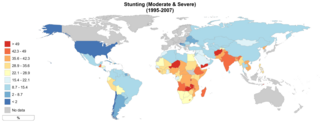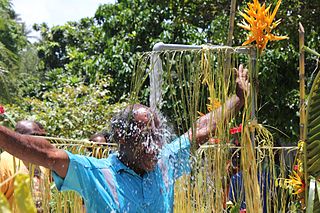Related Research Articles
Women's health refers to the health of women, which differs from that of men in many unique ways. Women's health is an example of population health, where health is defined by the World Health Organization as "a state of complete physical, mental and social well-being and not merely the absence of disease or infirmity". Often treated as simply women's reproductive health, many groups argue for a broader definition pertaining to the overall health of women, better expressed as "The health of women". These differences are further exacerbated in developing countries where women, whose health includes both their risks and experiences, are further disadvantaged.

The Millennium Development Goals (MDGs) were eight international development goals for the year 2015 that had been established following the Millennium Summit of the United Nations in 2000, following the adoption of the United Nations Millennium Declaration. The Sustainable Development Goals (SDGs) succeeded the MDGs in 2016.
Micronutrients are essential elements required by organisms in varying quantities throughout life to orchestrate a range of physiological functions to maintain health. Micronutrient requirements differ between organisms; for example, humans and other animals require numerous vitamins and dietary minerals, whereas plants require specific minerals. For human nutrition, micronutrient requirements are in amounts generally less than 100 milligrams per day, whereas macronutrients are required in gram quantities daily.

Global health is the health of populations in the global context; it has been defined as "the area of study, research and practice that places a priority on improving health and achieving equity in health for all people worldwide". Problems that transcend national borders or have a global political and economic impact are often emphasized. Thus, global health is about worldwide health improvement, reduction of disparities, and protection against global threats that disregard national borders. Global health is not to be confused with international health, which is defined as the branch of public health focusing on developing nations and foreign aid efforts by industrialized countries. Global health can be measured as a function of various global diseases and their prevalence in the world and threat to decrease life in the present day.
Primary Health Care, or PHC refers to "essential health care" that is based on scientifically sound and socially acceptable methods and technology. This makes universal health care accessible to all individuals and families in a community. It is through their full participation and at a cost that the community and the country can afford to maintain at every stage of their development in the spirit of self-reliance and self-determination. In other words, PHC is an approach to health beyond the traditional health care system that focuses on health equity-producing social policy. PHC includes all areas that play a role in health, such as access to health services, environment and lifestyle. Thus, primary healthcare and public health measures, taken together, may be considered as the cornerstones of universal health systems. The World Health Organization, or WHO, elaborates on the goals of PHC as defined by three major categories, "empowering people and communities, multisectoral policy and action; and primary care and essential public health functions as the core of integrated health services[1]." Based on these definitions, PHC can not only help an individual after being diagnosed with a disease or disorder, but actively prevent such issues by understanding the individual as a whole.

Child mortality, refers to the mortality of children under the age of five. The child mortality rate, also 'under-five mortality rate', refers to the probability of dying between birth and exactly five years of age expressed per 1,000 live births.

Stunted growth is a reduced growth rate in human development. It is a primary manifestation of malnutrition and recurrent infections, such as diarrhea and helminthiasis, in early childhood and even before birth, due to malnutrition during fetal development brought on by a malnourished mother. The definition of stunting according to the World Health Organization (WHO) is for the "height for age" value to be less than two standard deviations of the WHO Child Growth Standards median.
The Multiple Indicator Cluster Surveys (MICS) are household surveys implemented by countries under the programme developed by the United Nations Children's Fund to provide internationally comparable, statistically rigorous data on the situation of children and women. The first round of surveys (MICS1) was carried out in over 60 countries in mainly 1995 and 1996 in response to the World Summit for Children and measurement of the mid-decade progress. A second round (MICS2) in 2000 increased the depth of the survey, allowing monitoring of a larger number of globally agreed indicators. A third round (MICS3) started in 2006 and aimed at producing data measuring progress also toward the Millennium Development Goals (MDGs), A World Fit for Children, and other major relevant international commitments. The fourth round, launched in 2009, aimed at most data collection conducted in 2010, but in reality most MICS4s were implemented in 2011 and even into 2012 and 2013. This represented a scale-up of frequency of MICS from UNICEF, now offering the survey programme on a three-year cycle. The fifth round, launched in 2012, was aimed at offering countries the tools to do the final MDG data collection.
Maternal health is the health of women during pregnancy, childbirth, and the postpartum period. It encompasses the health care dimensions of family planning, preconception, prenatal, and postnatal care in order to ensure a positive and fulfilling experience, in most cases, and reduce maternal morbidity and mortality, in other cases.
The Demographic and Health Surveys (DHS) Program is responsible for collecting and disseminating accurate, nationally representative data on health and population in developing countries. The project is implemented by ICF International and is funded by the United States Agency for International Development (USAID) with contributions from other donors such as UNICEF, UNFPA, WHO, and UNAIDS.

The United Nations Children's Fund is a United Nations agency responsible for providing humanitarian and developmental aid to children worldwide. Operating out of U.N. headquarters in New York City, it is among the most widespread and recognizable social welfare organizations in the world, with a presence in 192 countries and territories. UNICEF's activities include immunizations and disease prevention, administering treatment for children and mothers with HIV, enhancing childhood and maternal nutrition, improving sanitation, promoting education, and providing emergency relief in response to disasters.

The Institute for Health Metrics and Evaluation (IHME) is a research institute working in the area of global health statistics and impact evaluation at the University of Washington in Seattle. The Institute is headed by Dr. Christopher J.L. Murray, a physician and health economist, and professor at the University of Washington Department of Global Health, which is part of the School of Medicine. IHME's goal, as stated on the Institute's website, is "to identify the best strategies to build a healthier world. By measuring health, tracking program performance, finding ways to maximize health system impact, and developing innovative measurement systems, IHME provides a foundation for informed decision-making that ultimately will lead to better health globally" IHME (2011). IHME conducts research and trains scientists, policymakers, and the public in health metrics concepts, methods, and tools. Its mission includes judging the effectiveness and efficacy of health initiatives and national health systems. IHME's work seeks to be complementary to the United Nations' work in the World Health Organization in that it shares many tasks but is independent from member countries.

WASH is an acronym that stands for "water, sanitation and hygiene". Universal, affordable and sustainable access to WASH is a key public health issue within international development and is the focus of Sustainable Development Goal 6. SDG 6 aims at equitable and accessible water and sanitation for all, with Target 6.2 specifically mentioning women and girls.

UCW: Understanding Children's Work is a programme to combat child labour. The 1997 Amsterdam Conference on Combating the Most Intolerable Forms of Child Labour and the 1997 Oslo International Conference on Child Labour both drew attention to the urgent need for concerted global action to end child labour, and called for an expansion of information gathering, statistics and empirical research to help inform this action. The inter-agency programme, Understanding Children's Work (UCW), was initiated by the International Labour Organization (ILO), UNICEF and the World Bank as one of the responses to the recommendations of the Amsterdam and Oslo conferences. Through a variety of research activities, the UCW Programme supports the partner agencies in improving statistical information on child labour in its various dimensions – its nature, extent, causes and consequences – as well as on what policy approaches are most effective in addressing it.
The post conflict South Sudan has huge challenges in delivering health care to the population. The challenges include: crippled health infrastructures, nearly collapsed public health system, and inadequate qualified health professionals. The country is far from achieving the MDGs by end of 2015. The health system needs a major resuscitation, in addition to supporting and developing health training institutions.
Both maternal and child health are interdependent and substantially contributing to high burden of mortality worldwide. Every year, 289 000 women die due to complications in pregnancy and childbirth, and 6.6 million children below 5 years of age die of complications in the newborn period and of common childhood diseases. Sub-Saharan Africa (SSA), which includes Tanzania, contribute higher proportion of maternal and child mortality. Due to considerable proportion of mortality being attributed by maternal and child health, the United Nations together with other international agencies incorporated the two into Millennium Development Goals (MDGs) 4 and 5. In this regard, Tanzania through the Ministry of Health and Social Welfare (MoHSW) adopted different strategies and efforts to promote safe motherhood and improve child survival. Similarly, in an effort to improve maternal and child health, Tanzania’s government has declared maternal and child health services to be exempt from user fees in government facilities.
Health Builders is a non-profit organization that uses systems-level interventions and infrastructure development to enable comprehensive primary health care for communities that need it. Its mission is to use business management principles to strengthen health systems and build healthy communities.

The Republic of Armenia was admitted into the United Nations on March 2, 1992. Since December 1992 when UN opened its first office in Yerevan, Armenia signed and ratified many international treaties. There are fifteen specialized agencies, programs and funds in the UN Country Team under the supervision of the UN Resident Coordinator. Besides, the World Bank (WB), International Finance Corporation (IFC) and International Monetary Fund (IMF) have offices in the country. The focus was drawn to the attainment of the Millennium Development Goals (MDGs) stipulated by the Millennium Declaration adopted during the Millennium Summit in 2000. The MDGs have simulated never before practiced actions to meet the needs of the world's poorest. As the MDG achievement date of December 2015 drew closer a new set of global sustainable development goals was consulted worldwide, to be adopted by the UN General Assembly in September 2015. Armenia was included in the initial group of 50 countries to conduct national consultations on the global Post-2015 development agenda.
Child health and nutrition in Africa is concerned with the health care of children through adolescents in the various countries of Africa. The right to health and a nutritious and sufficient diet are internationally recognized fundamental human rights protected by international treaties and conventions on the right to life, as well as in charters, strategies and declarations. Millennium Development Goals (MDGs) 1, 4, 5 and 6 highlight, respectively, how poverty, hunger, child mortality, maternal health, the eradication of HIV/AIDS, malaria, tuberculosis and other diseases are of particular significance in the context of child health.
Child Mortality in Ghana describes the child mortality in the country of Ghana. Like in other parts of the world, child mortality is declining in Ghana.
References
- ↑ The oldest – although unpublished – concept note available on the topic: MARGINAL BUDGETING FOR BOTTLENECKS: A NEW COSTING AND RESOURCE ALLOCATION PRACTICE TO BUY HEALTH RESULTS
Using health sector’s budget expansion to progress towards the Millennium Development Goals in Sub-Saharan Africa; A Soucat, W Van Lerberghe, F Diop, S N Nguyen and R Knippenberg
Draft version: November 2002, please do not quote http://www.gavialliance.org/resources/14_MBB_Concept_paper.pdf Archived 2010-06-26 at the Wayback Machine - ↑ Tanahashi 1978 bulletin of WHO_1978_56(2)_295-303 http://whqlibdoc.who.int/bulletin/1978/Vol56-No2/bulletin_1978_56%282%29_295-303.pdf%5B%5D
- ↑ Jones, Gareth; Steketee, Richard W; Black, Robert E; Bhutta, Zulfiqar A; Morris, Saul S (2003). "How many child deaths can we prevent this year?". The Lancet. 362 (9377): 65–71. doi:10.1016/S0140-6736(03)13811-1. PMID 12853204.
- ↑ Lives Save Tools developed by Johns Hopkins University see http://www.jhsph.edu/dept/ih/IIP/list/index.html
- ↑ as of July 2012
- ↑ "DevInfo MBB support website". Archived from the original on 2012-03-31.
- ↑ The State of the World Children 2008 : Child Survival, p 70 http://www.unicef.org/sowc08/